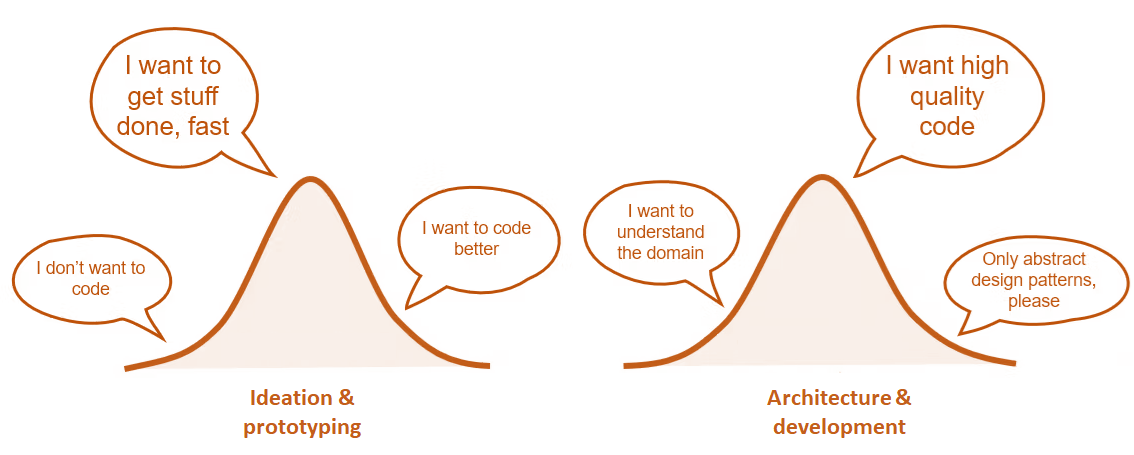Efficiency advancement
Armed with many years of consulting experience we learned to recognize organizational and cultural collaboration challenges and acquired practical hard & soft skills to bridge the divides, helping you advancing efficiency.
IT & Business gap. Towards a fusion team.
How many times have you heard a variation of “Business and IT need to work better together”? That piece of advice contains one of the most important challenges companies face to uphold their competitive edge.

The issue
Agile alone does not solve collaboration challenges. Despite closer cooperation between business and IT, traditional role patterns persist, leading to inefficiencies and wasted time—the so-called IT & business gap. Proposed solutions often agree: organizational adaptation is crucial. However, the ultimate goal remains growing interdisciplinary competencies in your team—a core value of Agile 2 (#4) . Yet, achieving this mix of IT and domain expertise demands abundant experience, intrinsic motivation, and time—challenging competencies to acquire.
Our approach
Since 2008, we have embraced the IT-business crossroads and are now uniquely positioned to assist. Our developers blend scientific expertise with interdisciplinary skills to deliver efficient software solutions across industries. Our mission is to expedite time-to-value and mitigate risk in digital ventures. We advocate for multidisciplinary fusion teams focused on business outcomes, actively engaging with your staff to enhance efficiency together. We provide the blend of skills to help you grow your capabilities.
Human skills & experience
- Soft skills
- Operating on both sides of the aisle
- Balancing seemingly conflicting interests, acting as effective liaisons
- Conscientiously influencing stakeholders in their decision-making processes
- Pursuing your autonomy: assume ownership with confidence
- Industry experience
- High-tech, automotive
- Finance and insurance (banking & regulatory)
- Energy, maritime and offshore
Technical skills
- Domain abstraction capabilities
- Quickly grasping domain-specific concepts
- Quickly finding our way, despite the jargon
- Used to abstractions, quickly gravitating to solutions
- Software and IT proficiencies
- Understanding IT concerns like security and access control
- Proficiency in Python, MATLAB, Julia, C++, C
- Operating all-round: from large OO designs to generated code
- Full-stack capabilities: front & backends, (web)apps, deployment
Domain experts & developers gap. Towards 'do the hard things first'.
Another common dimension of collaboration discord is the gap between domain experts and developers. From ideation to production, these worlds often collide, even within development teams. This also leads to diminished efficiency and wasted time.

The issue
Domain experts, like data analysts and scientists, prioritize quick exploration over coding finesse, while software developers prioritize code quality but may lack understanding of the underlying science. Time constraints worsen this gap. Known as the two-cultures problem problem, it leads to practices like building concepts in spreadsheets or hastily written code without documentation or design, sometimes put into production despite risks. We have participated in many migration projects to mature and productize such prototypes retroactively.

Source: Matthijs Cox - the Scientfic Coder.
https://scientificcoder.com/my-target-audience
Our approach
Here as well, the goal is to reduce time-to-value. We advocate for and facilitate the integration of prototyping and production environments, fostering a new culture right in the middle. This enables you to address the most challenging aspects first and streamline your journey from ideation to production for current and future projects, enhancing efficiency along the way.
- Roadmap:
- Identify most suitable language to implement for production
-
Pursue proof-of-concept approach where possible:
- Identify and tackle the hardest things first
- Design and build skeletons for validation
- Thereby proving solution intents at an early stage
-
Optimize for scalability and performance, from inception:
- Isolate and optimize performance-critical components
- Involve end-users and IT from the outset
